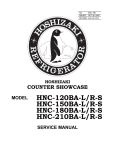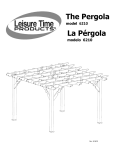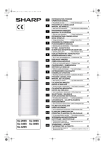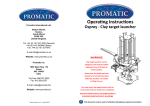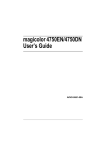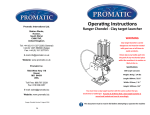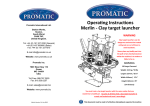Download Sharp SJ-380N Service manual
Transcript
SJ-A20S/B21S/A24S/B25S/A28A/B27S/A31S/A34S-SL SERVICE MANUAL No.S9902SJ22FTVTT Refrigerator-freezer MODELS Ag SJ-F230G SJ-F230G SJ-F230G SJ-A28S-SL SJ-B27S-SL SJ-A20S-SL SJ-B21S-SL SJ-A24S-SL SJ-B25S-SL SJ-A28S-SL SJ-B27S-SL SJ-A31S-SL SJ-A34S-SL DESTINATION T Refrigerant; HFC-134a Refer to "HFC-134a COOLING UNIT" Service Manual for handling this refrigerant. CONTENTS CHAPTER 1. SPECIFICATION [1] SJ-A20S/B21S/A24S/B25S/A28S/B27S........ 2-1 [2] SJ-A31S/A34S .......................................... 2-2 CHAPTER 2. DESIGNATION OF VARIOUS PARTS [1] EXTERNAL DESCRIPTION........................... 2-1 [2] CONSTRUCTIONS........................................ 2-2 CHAPTER 3. DIMENTIONS [1] OUTER DIMENTIONS AND CLEARANCE ................................................. 3-1 [2] INNER DIMENTIONS .................................... 3-4 CHAPTER 4. LIST OF ELECTRICAL PARTS CHAPTER 5. WIRING DIAGRAM [1] WIRING DIAGRAM ........................................ 5-1 [2] ELECTRIC ACCESSORIES LAYOUT ........... 5-2 [3] PRECAUTION FOR USING LEAD-FREE SOLDER........................................................5-3 CHAPTER 6. FAILURE DIAGNOSIS [1] OUTLINE OF CONTROL ............................... 6-1 [2] CHECK MODE OF DEFROST HEATER (Forced Defrosting) ........................................ 6-1 [3] [4] [5] [6] RE-SETTING OF MICROCOMPUTER AT POWER FAILURE.......................................... 6-2 DIAGNOSIS METHOD OF FAILURE ............6-2 CONVERSION TABLE ..................................6-3 CIRCUIT DIAGRAM OF MAIN PWB .............6-4 CHAPTER 7. FUNCTIONS [1] ADJUSTABLE TEMPERATURE CONTROL .....................................................7-1 CHAPTER 8. ASSEMBLI NG PROCEDURES OF MAIN PARTS AND CAUTIONS [1] F-LOUVER ASS'Y (SJ-A20S/B21S/A24S/ B25S/A28S/B27S)..........................................8-1 [2] F-LOUVER ASS'Y (SJ-A31S/A34S)...............8-4 [3] R CONTROL COV. ASS'Y.............................8-7 [4] HOW TO REPLACE THE LAMP ...................8-9 [5] DEFROST HEATER ......................................8-10 CHAPTER 9. COOLING UNIT [1] COOLING UNIT.............................................9-1 [2] LOCATION ....................................................9-2 Parts Guide This document has been published to be used for after sales service only. The contents are subject to change without notice. !"#$% &'$( &#$) &'$* &#$+ &'$, &#-( &#-) SJD34NSLG CHAPTER 1. SPECIFICATION Service Manual SJ-A20S/B21S/A24S/B25S/A28S/B27S SJ-A20S SJ-A24S SJ-B21S SJ-B25S Type 2-Door Outer dimensions Height 1253mm(49.3") 1389mm(54.7") Width 545mm(21.5") 545mm(21.5") Depth 620mm(24.4") 620mm(24.4") Rate storage volume (Rated volume) 184liter(6.5cu.ft) 212liter(7.5cu.ft) Heater system Defrosting System Automatic Start Automatic Finish Temperature control Automatic (Adjustable) No-frost freezer Yes Interior lamp 1 Evaporating pan 1 1 Freezer Compartment F-shelf Twin ice cube maker Ice cube maker 1 Ice storage box 1 Door pocket 1 Refrigerator Compartment Fresh case R shelf (plastic) 1 2 R shelf ass'y (glass) V shelf (plastic) 1 1 V shelf ass'y (glass) 1 Vegetable case 1 Egg pocket 1 Small pocket 1 Door pocket B 1 Bottle pocket 1 Door pocket Deodorizing unit 1 (Honeycomb type) Stand Yes SJ-A28S SJ-B27S Items 1491mm(58.7") 545mm(21.5") 620mm(24.4") 227liter(8.0cu.ft) 2 2 1 RATING SJ-A20S SJ-B21S Items Rated voltage (V~) Rated frequency (Hz) Climate class Rated power input (W) Rated current (A) Current input (A) Defrosting input (A) Defrosting power (W) Refrigerant (Charging quantity) [Non-flammable] Insulation blowing gas [Flammable] Net Weight (kg) 220 50 T 100 0.58 0.85 0.58 128 HFC-134a(75 g) HFC-134a(75 g) Cyclo pentane (HC) 39 41 PLUG TYPE Plug cord Plug type Destination mark 2 pin T COLOR Items Outside color Inside color -SL Silver White SJ-A24S SJ-B24S 1–1 SJ-A28S SJ-B27S HFC-134a(95 g) 45 !"#$% &'$( &#$) &'$* &#$+ &'$, &#-( &#-) SJD34NSLG SJ-A31S/A34S Service Manual SJ-A31S SJ-A34S 2-Door Height 1580mm(62.2") 1700mm(66.9") Width 600mm(23.6") 600mm(23.6") Depth 631mm(24.8") 631mm(24.8") Rated storage volume (Rated volume) 292liter(10.3cu.ft) 313liter(11.1cu.ft) Heater system Defrosting System Automatic Start Automatic Finish Temperature control Automatic (Adjustable) No-frost freezer Yes Interior lamp 1 Evaporating pan 1 1 Freezer Compartment F-shelf Twin ice cube maker Ice cube maker 1 Ice storage box 2 Door pocket 1 Refrigerator Compartment Fresh case R shelf ass'y (glass) 2 3 V shelf ass'y (glass) 1 1 Vegetable case 1 Egg pocket 1 Egg tray Small pocket 1 2 1 Door pocket B 1 Bottle pocket 1 Door pocket 1 (Honeycomb type) Deodorizing unit Items Type Outer dimensions RATING Items Rated voltage (V~) Rated frequency (Hz) Climate class Rated power input (W) Rated current (A) Current input (A) Defrosting current (A) Defrosting power (W) Refrigerant (Charging quantity) [Non-flammable] Insulation blowing gas [Flammable] Net Weight (kg) SJ-A31S 220 50 T 109 0.58 0.95 0.58 128 HFC-134a(100 g) Cyclo pentane (HC) 52 54 PLUG TYPE Plug cord Plug type Destination mark 2 pin T COLOR Items Outside color Inside color -SL Silver White 1–2 SJ-A34S !"#$% &'$( &#$) &'$* &#$+ &'$, &#-( &#-) SJ26NSL CHAPTER 2. DESIGNATION OFVARIOUS Service PARTSManual [1] EXTERNAL DESCRIPTION The names in parenthesis "[ ]" are the denominations used in the REPLACEMENT PARTS LIST. 1 12 2 3 13 4 14 5 15 6 16 7 17 18 8 19 9 1. Freezer shelf [F-shelf] 2. Freezer temp.control knob 3. Ice cube maker 4. Ice cube box [Ice storage box] 5. Fresh room 6. Refrigerator temp.control knob 7. Light [Lamp] 8. Refrigerator shelf [ R-shelf (plastic) : SJ-A20S/B21S; 1 pc. SJ-A24S/B25S; 2 pcs. R-shelf ass’y (glass) :SJ-A28S/B27S/A31S; 2 pcs, SJ-A34S; 3 pcs.] 9. Vegetable shelf [ R-shelf (plastic) : SJ-A20S/B21S/A24S/B25S, R-shelf (glass) : SJ-A28S/B27S/A31S/A34S ] 10. Vegetable crisper [Vegetable case] 11. Adjustable foot [Adjustable leg] 12. Magnetic door seal [Door packing] 13. Door pocket 10 13 (SJ-A20S/B21S/A24S/B25S; 2 pockets, SJ-A28S/B27S/A31S/A34S; 3 pockets) 14. Egg holder [Egg tray] 11 12 15. Egg pocket 16. Light switch 17. Small pocket (right) [Small pocket] (Only SJ-A31S/A34S) (SJ-A24S/B25S/A28S/B27S/A31S; 1 pocket, SJ-A34S; 2 pockets) 18. Small pocket (left) [Door pocket B] (SJ-A24S/B25S/A28S/B27S/A31S/A34S) 19. Bottle pocket 2–1 !"#$% &'$( &#$) &'$* &#$+ &'$, &#-( &#-) [2] CONSTRUCTIONS Mark: Cold air flow Fan motor F-temp. control knob Def-thermistor Evaporator Fuse ass'y Defrost heater Deodorizing unit R-temp. control knob R-thermistor PWB L ass'y Lamp Running capacitor Evaporating pan Compressor Starting relay Protector 2–2 !"#$% &'$( &#$) &'$* &#$+ &'$, &#-( &#-) SJD26LVSL CHAPTER 3. DIMENTIONS [1] OUTER DIMENTIONS AND CLEARANCE 1. SJ-A20S/B21S 60 628.5 610 60 60 545 443.5 545 1145 34 4 757.5 1085 1253 9 365 970 (Unit:mm) 2. SJ-A24S/B25S 60 628.5 610 60 60 545 9 443.5 545 1145 34 4 893.5 1085 1389 365 970 (Unit:mm) 3–1 !"#$% &'$( &#$) &'$* &#$+ &'$, &#-( &#-) 3. SJ-A28S/B27S 60 628.5 610 60 60 545 9 515.5 545 1145 34 4 923.5 1085 1491 365 970 (Unit:mm) 4. SJ-A31S 649.5 631 600 9 541.5 600 34 4 986.5 1065 3–2 1221 1161 1580 405 !"#$% &'$( &#$) &'$* &#$+ &'$, &#-( &#-) 5. SJ-A34S 649.5 631 600 9 34 4 1106.5 1161 1700 405 1065 [2] INNER DIMENTIONS 1. SJ-A20S/B21S 196 366 154 380 143 107 103 390 45 340 204 66 138 67 55 33 38 391 146 250 107 211 208 253 366 208 417 120 149 371 300 292 321 43 417 80 67 137 363 (Unit:mm) 3–3 1221 541.5 600 !"#$% &'$( &#$) &'$* &#$+ &'$, &#-( &#-) 2. SJ-A24S/B25S 38 55 33 366 66 154 138 45 143 103 390 340 107 67 380 204 196 391 187 91 30 292 271 371 154 120 107 417 86 417 292 434 68 211 208 253 366 208 43 417 214 250 169 180 80 137 67 363 (Unit:mm) 3. SJ-A28S/B27S 366 67 66 202 366 66 154 138 45 143 107 103 390 204 254 196 67 55 33 38 391 169 292 464 120 184 271 123 292 371 107 211 417 208 253 366 80 208 417 91 30 68 43 417 144 214 250 180 67 137 363 (Unit:mm) 3–4 !"#$% &'$( &#$) &'$* &#$+ &'$, &#-( &#-) 4. SJ-A31S 416 67 66 231 66 154 45 92 107 67 111 445 217 68 30 43 472 380 237 91 312 312 330 472 147 180 170 55 33 416 138 204 254 217 530 38 430 430 107 210 120 231 472 217 217 259 430 80 152 67 411 5. SJ-A34S 416 67 66 231 66 154 30 68 237 155 30 59 43 472 91 380 91 312 312 472 312 650 472 147 150 155 237 180 155 45 92 107 67 111 445 170 55 33 416 138 335 430 107 160 120 282 217 430 80 217 231 480 67 152 411 204 254 217 170 38 430 3–5 !"#$% &'$( &#$) &'$* &#$+ &'$, &#-( &#-) SJ26NSL CHAPTER 4. LIST OF ELECTRICAL PARTS ITEMS R Thermistor Defrost Thermistor TYPE NAME ― ― RATING DC 5V DC 5V SPECIFICATIONS R0 = 6.4 kΩ, B(0) = 3811 R0 = 6.4 kΩ, B(0) = 3811 Thermo. fuse SF70E Defrost heater ― Fan motor (A20S/B21S/A24S/B25S/ 3R00121 A28S/B27S) 250V 10A 220 - 240V 378Ω Working temp. : 70 °C 140W at 230V (A31S/A34S) 3R00101B AC 220-240V,50Hz ― AC 220-230V,60Hz Door switch SDKNA20101 250V 0.25A 125V 0.5 A 240V 15W R Lamp ― Compressor (A20S/B21S/A24S/B25S) FL0845-ST AC 200-240V, 50Hz ― 3 Terminals push-botton type #187 Straight Terminal, Pitch 6 220-240V/50Hz Cooling capacity : 106 W (50Hz) Main coil : 23.8 Ω Aux. coil : 29.7 Ω (at 75 °C) (A28S/B27S) FL1152-SZ 220-240V/50Hz Cooling capacity : 136 W (50Hz) Main coil : 23.8 Ω Aux. coil : 42.4 Ω (at 75 °C) (A31S/A34S) FL1257-SW 220-240V/50Hz Cooling capacity : 170 W (50Hz) Main coil : 18.4 Ω Main coil Aux. coil Aux. coil : 31.5 Ω (at 75 °C) Common Starting Relay PEN0SBT Overload Relay(Protector) 50/60 Hz 22 ± 4.4Ω (at 25 °C) (A20S/B21S/A24S/B25S) 5TM158RFBYY-53 ― Open/ Close : 120 ± 0.5 / 61 ± 9.0°C 5TM149NFBYY-53 ― Open/ Close : 120 ± 0.5 / 61 ± 9.0°C (A31S/A34S) 5TM189RFBYY-53 ― (A31S/A34S) Running capacitor (A20S/B21S/A24S/B25S/ RC-EZA237CBZZ ― A28S/B27S) RC-EZA249CBZZ ― (A31S/A34S) Open/ Close : 130 ± 0.5 / 61 ± 9.0°C Main PWB ― (A28S/B27S) FPWB-A667CBKZ 220-240V 4–1 400V 3 F 400V 4 F !"#$% &'$( &#$) &'$* &#$+ &'$, &#-( &#-) SJD26LVSL CHAPTER 5. WIRING DIAGRAM [1] WIRING DIAGRAM Be sure to replace the electrical parts with specified ones for maintaining the safety and performance of the set. COMPRESSOR STARTING RELAY (BL) RUNNING CAPACITOR 5–1 !"#$% &'$( &#$) &'$* &#$+ &'$, &#-( &#-) [2] ELECTRIC ACCESSORIES LAYOUT F-LOUVER ASS’Y CABINET FAN MOTOR FM LEAD EV COVER HARNESS FL ASS’Y FUSE DEF-THERMISTOR DEF-HEATER R-CBOX-K PWB LAMP R-THERMISTOR DOOR SWITCH TERMINAL COVER PROTECTOR COMPRESSOR RUN CAP. RELAY WIRE ASS’Y STARTING RELAY (BOTTOM ANGLE) 5–2 !"#$% &'$( &#$) &'$* &#$+ &'$, &#-( &#-) [ ] PRECAUTIONS FOR USING LEAD-FREE SOLDER 1. Employing lead-free solder The PWB of this model employs lead-free solder. This is indicated by the "LF" symbol printed on the PWB and in the service manual. The suffix letter indicates the alloy type of the solder. Example: Indicates lead-free solder of tin, silver and copper 2. Using lead-free wire solder When repairing a PWB with the "LF" symbol, only lead-free solder should be used. (Using normal tin/lead alloy solder may result in cold soldered joints and damage to printed patterns.) As the melting point of lead-free solder is approximately 40°C higher than tin/lead alloy solder, it is recommend that a dedicated bit is used, and that the iron temperature is adjusted accordingly. 3. Soldering As the melting point of lead-free solder (Sn-Ag-Cu) is higher and has poorer wettability, (flow), to prevent damage to the land of the PWB, extreme care should be taken not to leave the bit in contact with the PWB for an extended period of time. Remove the bit as soon as a good flow is achieved. The high content of tin in lead free solder will cause premature corrosion of the bit. To reduce wear on the bit, reduce the temperature or turn off the iron when it is not required. Leaving different types of solder on the bit will cause contamination of the different alloys, which will alter their characteristics, making good soldering more difficult. It will be necessary to clean and replace bits more often when using lead-free solder. To reduce bit wear, care should be taken to clean the bit thoroughly after each use. 5-3 !"#$% &'$( &#$) &'$* &#$+ &'$, &#-( &#-) SJ431NSL CHAPTER 6. FAILURE DIAGNOSIS Service Manual [1] OUTLINE OF CONTROL 1. ON/OFF Control of Compressor When the plug of refrigerator is connected, the compressor will start automatically and run for approximately 5 minutes. After then, ON/OFF of the compressor will be controlled depend on the temperature detected by the R-thermistor. During 6 minutes after the compressor stops, it will not start regardless of the detected temperature by R-thermistor.. 2. Defrosting Microcomputer calculates the appropriate timing of defrosting and defrosting is made automatically. Therefore no manual operation by user is required. The cycle of defrosting varies depend on the usage condition of the refrigerator. (Maximum time 50 hours, minimum time 4 hours) 3. Thermistor Thermistors are installed in 2 places; in the refrigerator compartment and close to the Evaporator. (R-thermistor and Def-thermistor) It is not installed in the freezer compartment. Def-thermistor R-thermistor reads the temperature in the refrigerator compartment and controls ON/OFF of compressor. Evaporator Def-thermistor detects the temperature around the evaporator and shows the progress of defrosting. Defrost heater R-thermistor PWB Compressor [2] CHECK MODE OF DEFROST HEATER (Forced Defrosting) The operation of the defrost heater can be checked by starting it. In case the failure of defrosting is suspected, this is an effective inspection method. 1. Starting Method At the power OFF condition. 1) Keep the door of the refrigerator compartment open. 2) Set the Temp. Control Knob in the refrigerator compartment to the following position. 220-240V models: Center (Center) 110-127V models: Max 3) Keep the door open and supply power source. 2. Normal Operation 1) Approximately 3 seconds after power supply, the relay on the PWB will be turned ON and the defrost heater will be electrified for 5 seconds. 2) After 5 seconds, if the temperature of Def-thermistor reaches high enough (over 10°C) and judged as defrosting completion, the compressor runs for 5 minutes and then returns to the normal control. On the other hand, if the temperature of Def-thermistor is still low (under 10°C), the defrost heater will be electrified until the temperature of Defthermistor reaches the specified temperature or higher. After completion of electrification, the compressor runs for 5 minutes and then returns to the normal control. * In the case that any abnormality in Door Switch, Volume, R-thermistor or Def-thermistor, or the Temp. Control Knob is not in the position corresponding to the value of the rating voltage settled to the PWB itself, this mode will not be entered nor the defrost heater is electrified. 6–1 !"#$% &'$( &#$) &'$* &#$+ &'$, &#-( &#-) [3] RE-SETTING OF MICROCOMPUTER AT POWER FAILURE • At the power failure for over 0.1 second, the control of the microcomputer will be reset. When the power is re-supplied, the temperature of R-thermistor will be detected again and ON/OFF of the compressor will be decided. • At the momentary power failure (less than 0.1 second), the protector of the compressor might work due to the high load to the compressor for restarting. • When resetting is made during the operation of the defrost heater, the normal cooling will be resumed. [4] DIAGNOSIS METHOD OF FAILURE Check by the following procedure; 1. Disconnect power supply and check the following point. • Is there any failure portion in inserting connectors? 2. Detach the PWB and check the appearance. • Is there any burning or abnormal damage? 3. Check the conditions of the fuse and the varistor. (Fuse and varistor are located at the position in the figure.) • Melting in the fuse cannot be checked visually (as the safer one than transparent glass tube is used). Be sure to detach the connector “CN1” before measuring the resistance between the both ends of the fuse by the tester. • Next, measure the resistance value between the both leads of the varistor. Varistor Fuse Varistor→ Fuse↓ Melting Conduction Normal (several hundreds Ω~several KΩ) D a m a ge Flow of excessive current is considerable for some reasons. Check for any portion to cause short circuits especially on the primary circuit. Fuse and varistor are normal. Possibility to be caused by excessive current or voltage near the power supply is low. Proceed to the next check item. There is a possibility of excessive voltage applied from outside with the factor such as thunder etc. When repeated with a factor other than thunder, there might be the apparatus near by generating noises. — 4. Check whether the temperature (resistance value) shown by R-thermistor is correct or not. (Refer to the table below.) • Detach the connector “CN3” on the PWB and measure the resistance value between 1 and 2 pins. 5. Check whether the temperature (resistance value) shown by Def-thermistor is correct or not. (Refer to the table below.) • Detach the connector “CN3” on the PWB and measure the resistance value between 3 and 4 pins. 6–2 !"#$% &'$( &#$) &'$* &#$+ &'$, &#-( &#-) [5] CONVERSION TABLE Conversion Table between R-thermistor and Def-thermistor Temperature and Resistance Value Temperature (°C) -25 -24 -23 -22 -21 -20 -19 -18 -17 -16 -15 -14 -13 -12 Resistance Value (kΩ) 26.1 24.54 23.08 21.72 20.46 19.27 18.16 17.13 16.16 15.25 14.4 13.6 12.85 12.15 Temperature (°C) -11 -10 -9 -8 -7 -6 -5 -4 -3 -2 -1 0 1 2 Resistance Value (kΩ) 11.49 10.88 10.3 9.75 9.24 8.76 8.3 7.87 7.47 7.09 6.74 6.4 6.08 5.78 6–3 Temperature (°C) 3 4 5 6 7 8 9 10 11 12 13 14 15 Resistance Value (kΩ) 5.5 5.23 4.98 4.74 4.52 4.3 4.1 3.91 3.73 3.56 3.4 3.24 3.1 !"#$% &'$( &#$) &'$* &#$+ &'$, &#-( &#-) [6] CIRCUIT DIAGRAM OF MAIN PWB 6–4 !"#$% &'$( &#$) &'$* &#$+ &'$, &#-( &#-) SJD26LVSL CHAPTER 7. FUNCTIONS [1] ADJUSTABLE TEMPERATURE CONTROL 1. Temperature control 1) FREEZER COMPARTMENT The FREEZER TEMP. CONTROL regulates the quantity of cold air to the freezer. "MAX" setting directs more cold air to the freezer compartment. (making the freezer compartment colder) "MIN" setting directs less cold air to the freezer compartment. (making the freezer compartment less colder) KNOB SETTING MAX PURPOSE For making ice rapidly of fast freezing. And winter season. When restocking with fresh food. For normal freezing. For storing frozen food for a short period (up to one month). When frozen food or ice cream is not stored. MID FREEZER TEMP.CONTROL MIN 2) REFRIGERATOR COMPARTMENT The REFRIGERATOR TEMP. CONTROL controls the compressor running time of the refrigeration system. "Coldest"(5) setting will result in colder temperature in the both (refrigerator and freezer) compartments. "MIN"(1) control setting will result in warmer temperature in the both (refrigerator and freezer) compartment. PURPOSE KNOB SETTING For keeping freshness of food longer. When the refrigerator does not provide sufficient cooling. For normal operation. When the refrigerator provides excessive cooling. MAX (Center) MIN REFRIGERATOR TEMP.CONTROL When refrigerator temperature control sets to the "MAX", some foods stored may become frozen. In this case adjust control set back to the center position. NOTE: • For hot summer conditions (about over 35 °C ambient temperature), set your FREEZER TEMP. CONTROL to less colder than "MID" (towards "MIN"). This is because "MAX" setting may result in too little air flow to the refrigerator compartment, causing too warm temperature in the refrigerator compartment. And set your refrigerator compartment freeze, you must set the REFRIGERATOR TEMP. CONTROL to less colder setting. (toward "MIN"). • In a cold kitchen (about under 10 °Cambient temperature), set your FREEZER TEMP. CONTROL to "MAX" to avoid too warm temperature in the freezer compartment. This is because the compressor operation is too short in winter, and not enough cold air is provided to the freezer compartment. And if the foods in the refrigerator compartment freeze, you must set the REFRIGERATOR TEMP. CONTROL to less colder setting. (toward "MIN"). • With the FREEZER TEMP. CONTROL set to "MAX" , there will be less cold air directed to the refrigerator compartment, and the refrigerator compartment may not become cold enough. 2. Reference value of temperature SETTING OF FREEZER TEMP. CONTROL KNOB MAX (Coldest) Freezer temperature Approx. MID Approx. MIN Approx. SETTING OF REFRIGERATOR TEMP. CONTROL KNOB Refrigerator temperature MAX (Coldest) (Center) MIN Approx. Approx. Approx. The values shown above refer to the case where the The values shown above refer to the case where the freezer temp. control knob is set at the center position. refrigerator temp. control knob is set at "MID". The values tables above refer to the measurement carried out center area and 1/3 of overall height from the bottom at each of the refrigerator and the freezer after the machine has been operated at an ambient temperature of 32 °C with no food stored and the door closed until the temperature is stabilized. The values vary depending upon frequency of opening and closing, the doors ambient temperature, amount of stored foods and manner of storing foods. 7–1 !"#$% &'$( &#$) &'$* &#$+ &'$, &#-( &#-) 3. Temp. control system Freezer Temp. Control Knob The FREEZER TEMP. CONTROL regulates the quantity of cold air to the freezer. MAX setting directs more cold air to the freezer compartment. (making the freezer compartment colder) MIN setting directs less cold air to the freezer compartment. (making the freezer compartment less colder) Fan Cold air Coldest FREEZER COMPARTMENT Coldest Evaporator much cold air less cold air FREEZER COMPARTMENT regulating the quantity of cold air. regulating the quantity of cold air. REFRIGERATOR COMPARTMENT REFRIGERATOR COMPARTMENT Compressor less cold air much cold air Refrigerator Temp. Control Knob The REFRIGERATOR TEMP. CONTROL controls the compressor & the fan running time of the refrigerator system. MAX setting will result in colder temperature in the both (refrigerator and freezer) compartments. MIN control setting will result in warmer temperature in the both (refrigerator and freezer) compartments. high cold power low cold power FREEZER COMPARTMENT REFRIGERATOR COMPARTMENT controlling the compressor & the fan running time controlling the compressor & the fan running time Normal operation (ex. at 20 C ambient temperature) Temp.( C) 30 OFF ON OFF ON Compressor & Fan 20 Ambient temperature 10 0 Refrigerator compartment temperature (at the center position) -10 -20 Time Freezer compartment temperature (at MID position) 7–2 !"#$% &'$( &#$) &'$* &#$+ &'$, &#-( &#-) SJD26LVSL CHAPTER 8. ASSEMBLING PROCEDURES OF MAIN PARTS AND CAUTIONS CAUTION: DISCONNECT THE UNIT FROM THE POWER SUPPLY BEFORE ANY REPAIRING. [1] F-LOUVER ASS'Y (SJ-A20S/B21S/A24S/B25S/A28S/B27S) 1. Fan motor ass'y Propeller fan 90 Fan motor holder a Fan clamp Lead EV-cover Slit area Motor cushion U-sealer handle Fan motor holder b Motor cushion Fan motor U-sealer handle Figure A-1 1. Stick U-sealer handle to Fan motor holder b (Fig. A-2). 2. Insert the terminal of Lead EV-cover to Fan motor (Fig. A-3). 3. Insert shaft of Fan motor to the hole of motor cushion, set at Fan motor holder b. Then insert the boss of rear to the hole of Motor cushion, fix with Tapping screw(1 piece). 4. Set Fan clamp to propeller fan 90 mm. and then insert it to the shaft of Fan motor( Fig. A-4). U-sealer handle Fan motor holder b Propeller fan 90 SEC. A-A Fan clamp Detail of D Fan motor holder a Fan motor holder b U-sealer handle Fan motor holder b Motor cushion Figure A-2 Fan clamp Motor cushion WIRE COLOR IS GRAY/ORANGE Propeller fan 90 (127V : with yellow tape) Fan motor Fan motor Lead EV-cover slit Fan clamp slit GOOD Figure A-3 Note (1) Assemble so that terminal of Fan motor does not deform. (2) Take care not to stress to terminals of Fan motor after wiring. (3) Check locking by pulling them with more than 10N(1 kgf). NO GOOD Figure A-4 Note (1) Slit of each Fan Clamp and propeller fan 100 should not be at same position. (2) Fan clamp should be inserted virtically to the end of boss. (3) Propeller fan should not be taken out from shaft when pulled by 2 kgf. 8–1 !"#$% &'$( &#$) &'$* &#$+ &'$, &#-( &#-) 2. EV-cover ass'y 1. Bind Fuse ass'y with L-band c. Then wind glass cloth tape (W25 x L50mm ) to lead wire of Fuse ass'y (Figure A-5). L-band c Fuse ass’y Glass cloth tape W25xL50 Figure A-5 2. Stick EVC-sealer a to square hole of EV-cover. 3. Set Fan motor ass'y to EV-cover. Then Fix with 2 tapping screw(Figure A-6) . 4. Set Fuse ass'y to EV-cover then stick aluminum tape (W39 x L35mm) and EV-cover al to EV-cover. 5. Set Def-thermistor to EV-cover and fix to Fan motor holder b with aluminum tape (W39 x L50mm ). 6. Insert the terminal of Def-thermistor to terminal No.5/No.6 and then insert the Fuse ass'y to the terminals No.1/No.2. on the 6P connector of Lead EV-cover (Figure A-7). 7. After wiring at rear of EV-cover take out lead wire from square hole to front and fix with L-band c. Then stick EVC-sealer b to lead wire. Lead EV-cover L-band c EVC-sealer a Tapping screw Fan motor ass’y T Tapping screw Def-thermistor EVC-sealer b Fuse ass’y Tapping screw Stick Al-tape from here L-band c L-band c EV-cover al Aluminum tape W39xL135 Glass cloth tape W25xL50 SEC. D-D Stick EV-cover al from this line Note Lead wire of Fuse ass’y must not over EV-cover. Figure A-6 SCALE 2:1 PL Process Note Pins should be inserted surely, and check by pulling it. FUSE (BLACK) (BLUE) Figure A-7 DEF THERMISTOR FAN MOTOR (WHITE) (GRAY/ORANGE) 8–2 !"#$% &'$( &#$) &'$* &#$+ &'$, &#-( &#-) 3. F - louver ass'y 1. Set F-louver to front side of EV-cover with double face tape (W15xL45mm.). 2. Insert F-control knob to F-louver. Then set to front side of EV-cover. 3. Stick EVC-sealer c to bottom of F-louver ass'y. Lead EV-cover more than 3.5mm. more than 3.5mm. Fan motor holder a F-louver F-louver Fan motor holder b F-control knob F-control knob Double face tape W15xL45 EV-cover NO CLEARANCE EVC-sealer c F-louver EV-cover Fan motor holder a Fan motor holder b Figure A-8 Attachment specification of the F-control knob The F-control knob is inserted into the ditch of the fan louver. F-louver F-louver F-control knob arm A F- louver EV-cover EV- cover F-control knob F-control knob arm A arm B arm B SEC. B-B Figure A-9 8–3 SEC. C-C !"#$% &'$( &#$) &'$* &#$+ &'$, &#-( &#-) [2] F-LOUVER ASS'Y (SJ-A31S/A34S) 1. Fan motor ass'y Fan motor holder b Tapping screw Motor cushion Motor cushion Fan motor U-sealer handle Fan motor holder a Tapping screw Slit area Fan clamp U-sealer handle Lead EV-cover BROWN RED Propeller fan 100 Figure A-1 1. Stick U-sealer handle to Fan motor holder a (Fig. A-2). 2. Insert the terminal of Lead EV-cover to Fan motor (Fig. A-3). 3. Insert shaft of Fan motor to the hole of motor cushion, set at Fan motor holder a. Next, insert the boss of rear to the hole of Motor cushion, set at fan motor b. Then fix with Tapping screw (2 pieces). 4. Set Fan clamp to propeller fan 100 mm. and then insert it to the shaft of Fan motor( Fig. A-4). Fan motor holder a Fan motor holder a Propeller fan 100 U-sealer handle Fan clamp Detail of D Fan motor holder a U-sealer handle Fan motor holder b SEC. C-C Motor cushion Figure A-2 Fan clamp WIRE COLOR IS GRAY/ORANGE Motor cushion (127V : with yellow tape) Propeller fan 100 Fan motor Fan motor slit Fan clamp slit Lead EV-cover GOOD Figure A-3 Note (1) Assemble so that terminal of Fan motor does not deform. (2) Take care not to stress to terminals of Fan motor after wiring. (3) Check locking by pulling them with more than 10N(1 kgf). Note NO GOOD Figure A-4 (1) Slit of each Fan Clamp and propeller fan 100 should not be at same position. (2) Fan clamp should be inserted virtically to the end of boss. (3) Propeller fan should not be taken out from shaft when pulled by 2 kgf. 8–4 !"#$% &'$( &#$) &'$* &#$+ &'$, &#-( &#-) 2. EV-cover ass'y 1. Bind Fuse ass'y with L-band c. Then wind glass cloth tape (W25 x L50mm ) to lead wire of Fuse ass'y (Figure A-5). L-band c Fuse ass’y Glass cloth tape W25xL50 Figure A-5 2. Stick EVC-sealer a to square hole of EV-cover. 3. Set Fan motor ass'y to EV-cover. Then Fix with 3 tapping screw(Figure A-6) . 4. Set Fuse ass'y to EV-cover then stick aluminum tape (W39 x L35mm) and EV-cover al to EV-cover. 5. Set Def-thermistor to EV-cover and fix to Fan motor holder b with aluminum tape (W39 x L50mm ). 6. Insert the terminal of Def-thermistor to terminal no.5/No.6 and then insert the Fuse ass'y to the terminals No.1/No.2. on the 6P connector of Lead EV-cover (Figure A-7). 7. After wiring at rear of EV-cover take out lead wire from square hole to front and fix with L-band c. Then stick EVC-sealer b to lead wire. Lead EV-cover L-band c EVC-sealer a Tapping screw Fan motor ass’y Tapping screw Def-thermistor EVC-sealer b Fuse ass’y Aluminum tape W39xL50 Tapping screw Stick Al-tape from here L-band c L-band c EV-cover al Aluminum tape W39xL135 Glass cloth tape W25xL50 SEC. D-D Stick EV-cover al from this line Note Lead wire of Fuse ass’y must not over EV-cover. Figure A-6 SCALE 2:1 PL Process Note Pins should be inserted surely, and check by pulling it. FUSE (BLACK) (BLUE) Figure A-7 DEF THERMISTOR FAN MOTOR (WHITE) (GRAY/ORANGE) 8–5 !"#$% &'$( &#$) &'$* &#$+ &'$, &#-( &#-) 3. F - louver ass'y 1. Set F-louver to front side of EV-cover with double face tape (W15xL45mm.). 2. Insert F-control knob to F-louver. Then set to front side of EV-cover. 3. Stick EVC-sealer c to bottom of F-louver ass'y. Lead EV-cover more than 3.5mm. more than 3.5mm. Fan motor holder a F-louver F-louver Fan motor holder b F-control knob F-control knob Double face tape W15xL45 EV-cover NO CLEARANCE EVC-sealer c F-louver EV-cover Fan motor holder a Fan motor holder b Figure A-8 Attachment specification of the F-control knob The F-control knob is inserted into the ditch of the fan louver. F-louver F-louver F-control knob arm A F- louver EV-cover EV- cover F-control knob F-control knob arm A arm B arm B SEC. B-B Figure A-9 8–6 SEC. C-C !"#$% &'$( &#$) &'$* &#$+ &'$, &#-( &#-) [3] R CONTROL COV. ASS'Y R-Control knob R-C Box cover Control label Lamp Figure A-10 1. Insert Lead R-Thermistor to Lead R-C Box. 2. Inset Lead R-C box to PWB L ass'y. 3. Assemble the PWB L ass’y with PWB holder A and then assemble the PWB holder A with PWB holder B. 4. Stick the R-control AL on PWB holder A/B ass’y. Lead R-C Box PWB holder B Lead sealer PWB holder A PWB holder A Lead R-C Box Lead R-Thermistor( White wire) R-control AL Figure A-11 PWB holder B 8–7 !"#$% &'$( &#$) &'$* &#$+ &'$, &#-( &#-) 5. Assemble Lamp with R-C Box cover then fix with 2 tapping screw. 6. Stick Knob sealer on R-C Box cover and then insert Knob joint to R-C Box cover. 7. Assemble the PWB ass'y with R-C Box cover. And place the R-Thermistor on the groove of R-C Box cover. 8. Insert Lead R-C Box to Lamp. R-C Box cover R-C Box cover Knob joint Knob sealer Figure A-12 PWB holder Lamp R-Thermistor R-C Box cover Figure A-13 9. Insert R-Control knob to R-C Box cover. 10.Stick Control Label on R-C Box cover. Control label R-Control knob Figure A-14 8–8 !"#$% &'$( &#$) &'$* &#$+ &'$, &#-( &#-) [4] HOW TO REPLACE THE LAMP 1. Remove the Light cover. 2. Remove the 2 screw, and pull the Lamp out. Screw 3. Insert the new Lamp to the connector, and fix with 2 screws. 4. Set the Light cover. 8–9 !"#$% &'$( &#$) &'$* &#$+ &'$, &#-( &#-) [5] DEFROST HEATER 2. Replacement of Def. heater. 1. Taking-out Evaporator 1. Remove the aluminium tape on Heater support to take it off from the food liner. 1. Take-out Fan louver ass’y. 2. Raise the protrusion part of Heater support. Then remove Heater cover. 2. Take-out E.V cover ass’y. Protrusion parts Evaporator Heater support Food liner convex part Figure A-15 Heater cover 3. As shown in Figure A-15, pull the upper part of Evaporator toward you, pull it diagonally so that the pipe of Evaporator does not contact the convex part of food liner. Protrusion part of Drain support al(2 pcs.) Food liner convex part Evaporator Def. heater ass'y Pipe Heater cover Figure A-18 3. Open Def.heater fixed part of Heater support al to the right and left, then remove Def.heater ass’y. Figure A-16 4. Pull the Evaporator for remove as shown in Figure A-16. NOTE: When pulling Evaporator and bending the pipes,pay attention so as not to break and deform the pipes. Still, take care not to hurt yourself by fin of Evaporator. Fixed parts Heater support Evaporator Def.heater ass’y Figure A-17 Figure A-19 8 – 10 !"#$% &'$( &#$) &'$* &#$+ &'$, &#-( &#-) 3. Installing of Evaporator 4. Replace Def. heater ass’y with new one. 1. Install Evaporator as shown in Figure.A-15 in the reverse order of Figure.A-16. Heater cover 2. Correct the deformed fin. NOTE: 1.When installing Evaporator, take care not to deform significantly and break the pipes. Def. heater ass'y 2.Take care not to damage the lead wires and hurt yourself by the fin of Evaporator. 3.You shouldn’t touch Defrost Heater with your bare hand. (you should were pure gloves) 4.You should wipe that with alcohol. When you touch Defrost heater with your bare hand. Heater support Figure A-20 5. Bend end of heater support 90. BEND BEND Heater Support Figure A-21 6. Assemble Defrost heater to Heater Support. 7. Assemble Heater cover to Heater Support. Bend top edge to outside. 4P Defrost Heater Heater support Figure A-22 8. Roll the leading wire Sealer to Lead wire Defrost Heater. 4P BEND BEND Figure A-23 8 – 11 !"#$% &'$( &#$) &'$* &#$+ &'$, &#-( &#-) SJ26NSL CHAPTER 9. COOLING UNIT Service Manual [1] COOLING UNIT NOTE: The iron pipe is partly used of this refrigerator. Please note the following points when brazing the iron pipe. • Brazing material should be silver brazing rod. (To be equivalent with BAg-20 or BAg-7) • Flux should be FB3A type. (It should be non-chlorine type). • Place an iron plate or cloth on the base frame to prevent the flux fall. • Remove the paint and plating on the pipe by the sandpaper before start repairing. • If you cut the iron pipe for repairing, remove the plating on the iron pipe end (20mm) by the sandpaper. • Put the flux on silver brazing rod and dry the flux by the flame of the torch, and then start brazing. • Remove the flux completely by the wire brush , and wipe off by the cloth after brazing. • Leakage inspection should be done when compressor is running. • After removing flux, paint the black enamel paint on the brazing part. Mark: Refrigerant flow Mark: Brazing portion Hot pipe L (Side condenser) Hot pipe (DP-condenser) Hot pipe R (Side condenser) Back condenser Evaporator Suction pipe Copper pipe Discharge P connector S.P connector Compressor Iron pipe Capillary tube Dryer connector Dryer * Copper back condenser is used in some models.Before repairing,check the Back condenser is copper or iron. 9–1 !"#$% &'$( &#$) &'$* &#$+ &'$, &#-( &#-) [2] LOCATION 1. Location 1 Dryer Capillary tube Dryer connector Hot pipe Charge pipe Evaporator Charge pipe L Back condenser * Suction pipe S.P Discharge connector P connector Compressor Mark shows Cu brazing points Mark shows Ag brazing points 2. Location 2 Discharge P. connector to Back condenser * Back condenser to Hot pipe Pinch Point D.P. butyl Pinch point Dryer connector to Dryer Hot pipe to Dryer connector Charge pipe to Dryer S.P connector to Compressor's suction tube Suction butyl Charge pipe L to Compressor's process tube Compressor's discharge pipe to Discharge P. connector Dryer to Capillary tube S.P connector to Suction pipe Mark shows Cu brazing points Mark shows Ag brazing points * Copper back condenser is used in some models.Before repairing,check the Back condenser is copper or iron. 9–2


































